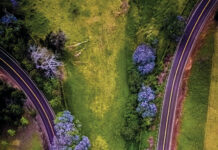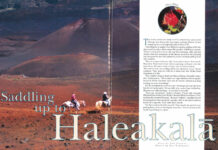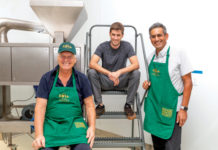While perhaps little known in his own neighborhood, Merwin is recognized beyond Hawai‘i as one of the greatest living poets. Now in his ninetieth year, he no longer makes public appearances, though his poems — and now his palms — speak for him.
Born in New York in 1927, Merwin spent his childhood in New Jersey and Pennsylvania. His career as gadfly began at age three, when he protested the cutting of an apple tree in his parents’ backyard. He has never stopped interrogating people’s relationship to their natural environment. During his undergraduate studies at Princeton, Merwin visited Ezra Pound in a sanatorium. The elder poet advised the student to “read the seeds, not the twigs of poetry,” write seventy-five lines a day, and master English by translating foreign literature. Merwin did so, translating works from a dozen languages, including French, Spanish, Sanskrit, Japanese, Middle English and Quechua.
Merwin lived for periods in New York City and Chiapas, and owned a farmhouse in Southern France. He tutored English poet Robert Graves’s son in Majorca and befriended Ted Hughes and Sylvia Plath in London. All the while, he wrote book after book of poems praised as visionary, spare, and enigmatic. He collected nearly every important prize for poetry. He won his first of two Pulitzers in 1971, and caught flak for donating the prize money to Viet Nam draft resisters.
Merwin came to Hawai‘i to study Zen Buddhism under the tutelage of Robert Aitken. The poet was so taken by the meditative practice that he moved into a leaky shack above Aitken’s house in Ha‘ikū. He arrived in 1976 — the same year the Hawaiian cultural renaissance began in earnest. That January, activists protested the military’s bombardment of Kaho‘olawe by illegally occupying the island. Later that summer, the Polynesian Voyaging Society sailed from Honolua Bay to Tahiti aboard a double-hulled canoe, proving that Polynesians ranked among history’s greatest navigators. Kanaka maoli (native Hawaiians) were reclaiming their ancestral strengths and finding new political voices.
Merwin not only witnessed this revolution, he participated. When restoration efforts began on Kaho‘olawe, he volunteered several times. In 1990, he helped found Environment Hawai‘i, a monthly newsletter that serves as a clarion voice for native ecosystems. He and newsletter editor Patricia Tummons sponsored water-rights conferences in three of Hawai‘i’s most contested valleys: Waipi‘o on Hawai‘i Island, Ke‘anae on Maui, and Waiāhole on O‘ahu. At Waiāhole, Merwin joined two hundred Hawaiian farmers in rebuilding an ancient lo‘i kalo (taro patch).





